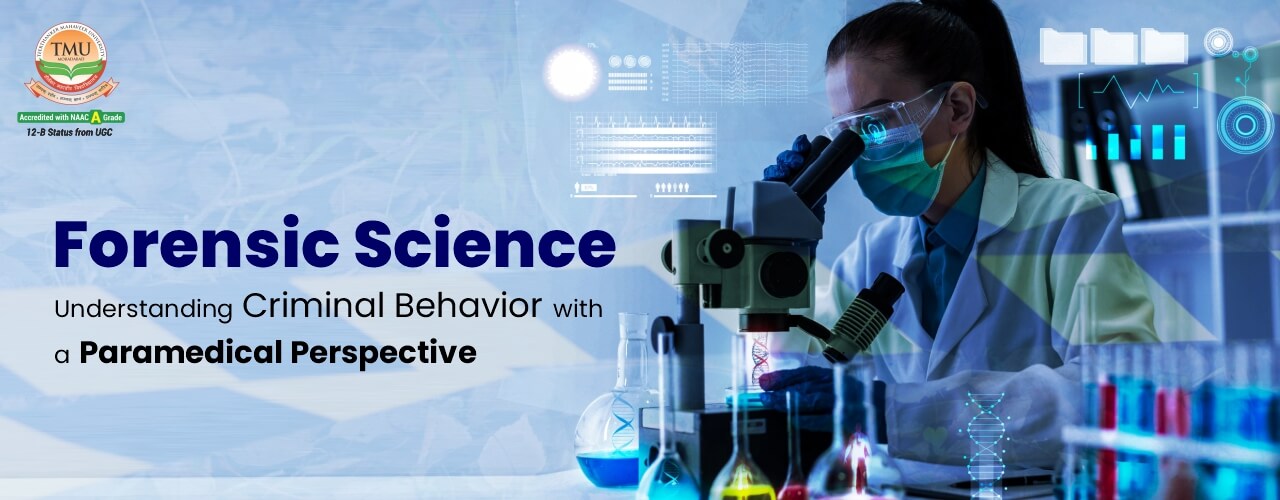Forensic Science: Understanding Criminal Behavior with a Paramedical Perspective
Table of Contents
Solving crimes and finding the culprits behind it involves mixing smart thinking about how criminals behave and using science to help investigate. Professionals dive into the world of criminal psychology and forensic science to unwind the puzzles that crimes create. By exploring these two different fields, we can see how they work together and learn how a Bachelor of Science (B.Sc.) in Forensic Science helps us get a better grip on understanding criminal behavior.
Understanding Criminal Behavior:
Criminal psychology predominantly seeks to comprehend the underlying reasons behind unlawful acts. Specialists in this domain delve into exploring the motivations, cognitive processes, and emotional nuances of individuals who perpetrate criminal activities. This encompasses studying behavioral patterns, discerning motives, and potentially profiling offenders. The overarching objective is not confined to comprehending why a specific crime has transpired, but also to anticipate and possibly avert future transgressions.Exploring criminal behavior embarks on a quest to understand the distinct and complex aspects of a criminal’s actions and mindset. Researchers aim to unravel pivotal questions: Why is an offense committed? Who are the culprits? How does their thought process work? What actions do they undertake?
Teerthanker Mahaveer University
Apply for Admission
Click Here To Apply for Admission
Factors Leading to Criminal Behavior
- Family Dynamics:Exposure to violent behaviors within the family unit can perpetuate a cycle where children may adopt learned aggressive behaviors.
- Financial Strain and Basic Needs:The struggle to fulfill fundamental needs may drive individuals to criminal acts as a means of survival or attaining desired items.
- Socioeconomic Pressures:Feeling inferior due to lower socioeconomic status may prompt some to engage in criminal activities as a misdirected effort to elevate their standing or to cope with societal pressures.
- Genetics and Psychological Factors: Some psychological issues or predispositions, such as aggressive tendencies, might have genetic roots that contribute to antisocial behaviors.
- Mental Health Challenges:A significant portion of incarcerated individuals possess a mental health condition, according to the National Institute of Mental Health, indicating a link between mental health issues and criminal activities.
Navigating through the varied causes of criminal behaviors showcases the complexity and individuality inherent in each case. Addressing these roots, from familial to psychological, is pivotal for devising effective preventive strategies and therapeutic interventions, moving towards not only a just but also a supportive and rehabilitative justice system.
Approaches Illustrating Criminal Behavior
There are various approaches and explanations that stir up criminal tendencies. Some of them include, psychological Models, sociological Models, biological models.- Psychological aspect: Crime control policies using psychology aim to stop criminal behavior at its start by focusing on the person. These policies use psychology by offering things like training, helping people get back on track, and learning about themselves. The ideas from psychology about criminal behavior make some assumptions. One main idea is that what's seen as "normal" is decided by what most people in society agree on. Also, while each person may do criminal things to meet certain needs or wants, unusual mental processes leading to this behavior can come from different places like mental health issues, learning in a way that’s not aligned, or internal struggles. These ideas suggest that policies should address both stopping and helping to recover from criminal behavior.
- Sociological aspect: Social control theory suggests that individuals are more likely to participate in criminal acts when their social bonds are weak. This stems from the innate human concern for others' perceptions and a general tendency to conform to societal expectations due to attachments and relationships with others. From a sociological viewpoint, discussions on criminality engage in exploring how the internal conflicts and interplay among various social groups, including societal, familial, and peer groups, contribute to criminal behavior. This involves the nuanced task of connecting an individual’s criminality to broader, often more complex, social structures and cultural values. It entails viewing criminality through a lens that understands it as a social construct, deeply embedded and potentially originated from its social causes and contexts. Therefore, the sociological analysis of criminality navigates through understanding how larger social dynamics, structures, and conflicts can intricately influence and shape individual choices and behaviors, thereby culminating in criminal activities.
- Biological aspect: Biological theories of criminal behavior suggest that an individual's physiological makeup might contain certain flaws that predispose them to criminal actions. The Raine Study, for instance, delves into the possibility that such physical flaws might be attributed to various factors, including heredity, neurotransmitter dysfunction, or brain abnormalities, which could be a result of genetic issues, improper development, or trauma. Several theories, such as Trait and Psychodynamic Trait Theories, Lombroso’s Theory, and Y Chromosome Theory, embrace biological approaches, insinuating inherent or physical attributes that might be linked to criminal behavior. In terms of crime control through the lens of biological theories, methods that involve artificial intervention in human biology, such as psychosurgery, chemical methods of control, and brain stimulation, are employed, all with the objective of modulating or rectifying the biological factors believed to be contributing to the individual's propensity for criminal activity. This showcases a multifaceted approach to understanding and potentially mitigating criminal behavior by addressing its hypothesized biological roots.
Risk Factors in Criminality
Identifying risk factors is crucial in comprehending why an individual may veer towards illicit activities. These factors, deeply embedded in a person's psychology, heighten the likelihood of engaging in criminal activities. Some of these include:- Behavior Disorder: An inability to conform to social norms and regulations
- Lack of Education:Limited access to or absence of educational opportunities.
- Media Influence: The impact and potential glamorization of crime in various media platforms.
- Poor Personal Temperament: Difficulty in managing anger or frustrations.
- Low IQ: Lower cognitive function, which might limit understanding consequences.
- Antisocial Beliefs:Holding beliefs that don’t align with societal norms and laws.
- Influence of Society: The societal norms and values that may inadvertently encourage criminal actions.
- Poor Parenting: Lack of adequate guidance, support, or supervision during childhood
Evaluation of Criminal Behavior
The evaluation of criminal behavior facilitates an understanding of its prevalence and characteristics. Generally, the assessment of criminal actions involves various metrics:- Arrests and Charges: Data regarding individuals detained or charged for illicit activities.
- Self-Reported Offenses: Information acquired from individuals who confess their own unlawful acts.
- Actual Crime Rates: Statistics that reveal the actual instances of crimes within a specific duration or area.
Understanding and measuring criminal behavior not only enlightens our comprehension of the criminal mindset but also guides strategies in risk management, intervention, and policy-making. Unraveling the multi-faceted aspects of why, how, and what propels individuals toward criminality remains pivotal for a safer and just society.
Research highlights shared biological traits among diverse violent offenders, with particular attention to the amygdala's role in aggression and fear. Smaller or underperforming amygdalas have been associated with a predisposition to violent and psychopathic behaviors, sometimes observable from early childhood. Furthermore, interventions, from early childhood or even prenatal initiatives to adult-life programs like yoga or dietary supplementation, have demonstrated potential in reducing violent tendencies and criminal activities. This suggests that even with biological predispositions, appropriate interventions can influence and potentially mitigate violent behaviors.
B.Sc. in Forensic Science: A Keystone in Forensic Science and Crime Investigation
Undertaking a B.Sc. in Forensic Science propels students into the empirical realm of crime investigation. The curriculum inculcates the skills required to scrutinize physical evidence derived from crime scenes, which may include DNA, fingerprints, and other crucial clues, thus enabling the establishment of a connection between a suspect and a crime scene or victim.Forensic scientists operate with meticulous precision to ensure that evidence is collected, preserved, analyzed, and interpreted with utmost accuracy. This scientific discipline not only aids in deciphering crimes but also plays a vital role in ensuring justice through the provision of reliable evidence in court proceedings.
The Interplay: Criminal Behavior and Forensic Science
The synthesis of understanding criminal behavior and forensic science is indispensable in contemporary crime resolution. Here is how they mutually augment each other:- Criminal Profiling:Acumen in criminal behavior assists in creating profiles, which subsequently guide forensic scientists towards pertinent evidence and patterns
- Evidence Understanding:Forensic evidence can unveil a criminal's behaviors and patterns, assisting psychologists in comprehending their mentality and prognosticating future activities.
- Legal Proceedings Both fields coalesce in the courtroom, wherein psychological comprehensions and physical evidence are amalgamated to construct a case.
- Rehabilitation: Insights derived from forensic science can inform criminal psychologists in formulating effective rehabilitation programs by understanding the criminal’s history and behavioral patterns.
In essence, while criminal psychology seeks to unravel the 'why' behind a crime, forensic science illuminates the 'how'. Together, they forge a robust approach towards understanding, resolving, and precluding criminal activities.
The B.Sc. in Forensic Science plays a pivotal role, interlinking the understanding of criminal psychology and the application of scientific principles in criminal investigation. As aspiring forensic scientists embark upon their academic voyage, they are not merely honing their scientific and investigative skills but also subtly immersing themselves in comprehending the intricate interplay between a criminal’s mind and the tangible evidence left in their wake. Consequently, this educational pursuit forms a crucial link, seeking to hold perpetrators accountable and ensuring that justice is dispensed with empirical and psychological acumen.















